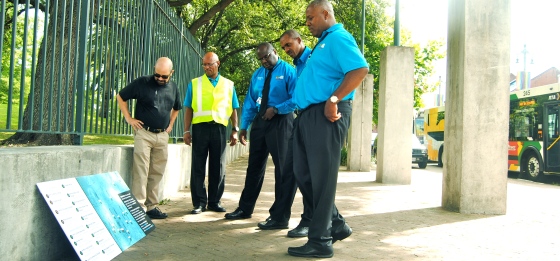Chapter 4 from our report summarizing the lessons we learned on the Great American Adaptation Road Trip. We partnered with the Georgetown Climate Center to get this to you. Chapter 5 coming soon.
Take-home lesson #4: Resilience efforts that span multiple government departments or include non-governmental actors are often able to leverage resources and expertise and create wider buy-in for action.
For local governments, the ability to prepare for the impacts of climate change is often limited by available resources and expertise. In some cases, local governments have the motivation to lead adaptation action but lack capacity and knowledge in areas like coordinating volunteers and implementing new technological tools. In other instances, non-profit groups or individual citizens may ‘push’ local government to act. By creating new partnerships across government departments as well as beyond government doors, city planners may be able to fill critical gaps in their own resources, accomplish ambitious goals, and more effectively address the cross-cutting nature of climate change impacts.
Partnerships across local government can help tackle the multiple facets of climate risk. In Baltimore, Maryland, the Planning Department is working with relevant city departments to help understand the city’s climate risks and find integrated solutions. For example, as Baltimore’s urban heat island intensifies with climate change, one goal of the Department of Recreation and Parks is to increase the urban tree canopy to reduce inner city temperatures by up to 9 degrees Fahrenheit.
But tree planting is a long-term solution. In the shorter term, the city’s Health Department is implementing the Code Red Program to open cooling centers on days that reach above 105 degrees Fahrenheit on the heat index. Coordinated by the Planning Department, staff across city agencies are working together to better understand the climate projections for the region so they can make sure residents have a safe place to go during heat waves in the near future, while also working to reduce the health risks long-term.
Implementation tip #4: Expand partnerships beyond the usual suspects. By working across sectors, communities will be stronger and more prepared for climate changes.
Local governments are also partnering with non-governmental actors such as private companies, community groups, and non-profit organizations to enhance community resilience and tap into creative, outside-the-box solutions. For instance, San Francisco’s Department of Emergency Management recently teamed up with web-based bed-and-breakfast company Airbnb to identify technological strategies that can help the city keep residents safe during disasters. The idea arose after one Airbnb user posted a room in their apartment for free during Hurricane Sandy in October 2012. The company then created the Airbnb Disaster Response program, which allows hosts to automatically offer free housing to people displaced by extreme events. After taking note of this innovative shelter-sharing concept, the City of San Francisco is now working with Airbnb to see how the model could be used for other aspects of emergency management.
In some cases, grassroots movements or individual citizens may provide local governments with a ‘push’ to move forward on a project that enhances resilience. After Brad Lancaster discovered that he could capture precious stormwater for his sidewalk garden by cutting an indent in his street curb, he approached the city of Tucson, Arizona to create a $50 curb cut permit so that his neighbors could harvest rainwater too. The curb cuts also benefit the desert city: they divert rainwater that would otherwise be lost to runoff, reducing flooding (and therefore potholes) and watering the municipal trees which shade increasingly hot city sidewalks. Lancaster’s neighbors now harvest two acre-feet of rainwater per year with curb cuts, contributing to luscious, canopied streetside gardens that provide much-needed shade as Tucson’s summers heat up.


